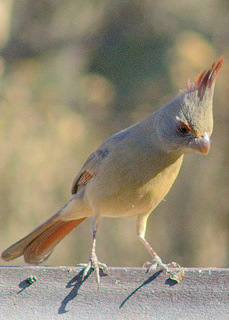| Line 12: | Line 12: | ||
This bird is fairly common in thorny brush and mesquite thickets of dry streambeds, desert, woodland edges and ranchlands. | This bird is fairly common in thorny brush and mesquite thickets of dry streambeds, desert, woodland edges and ranchlands. | ||
==Behaviour== | ==Behaviour== | ||
| + | |||
| + | |||
| + | [[Image:Pyrrhuloxia_Female.jpg |left|Photo by Larry D Smith - Pyrrhuloxia_Female http://www.SouthwestNaturePhotos.com/Larry]] | ||
| + | |||
The song is a liquid whistle, thinner and shorter than the song of the Northern Cardinal. The call is a sharp "chink". | The song is a liquid whistle, thinner and shorter than the song of the Northern Cardinal. The call is a sharp "chink". | ||
| − | In a loosely built cup of grass, twigs, and bark strips concealed in dense, thorny bush, 3 or 4 white eggs, lightly speckled with brown, are laid. These birds feed on seeds and insects and benefit cotton fields by destroying great numbers of cotton worms and weevils. When approached, a pair will fly up to a high watch post, erect their crests, and sound a loud alarm. | + | In a loosely built cup of grass, twigs, and bark strips concealed in dense, thorny bush, 3 or 4 white eggs, lightly speckled with brown, are laid. These birds feed on seeds and insects and benefit cotton fields by destroying great numbers of cotton worms and weevils. When approached, a pair will fly up to a high watch post, erect their crests, and sound a loud alarm. |
==External Links== | ==External Links== | ||
*[http://www.birdforum.net/pp_gallery/showgallery.php?mcats=all&what=allfields&si=Pyrrhuloxia+ View more images of Pyrrhuloxia in the gallery] | *[http://www.birdforum.net/pp_gallery/showgallery.php?mcats=all&what=allfields&si=Pyrrhuloxia+ View more images of Pyrrhuloxia in the gallery] | ||
[[Category:Birds]] | [[Category:Birds]] | ||
Revision as of 21:43, 3 October 2007
- Cardinalis sinuatus
Identification
The Pyrrhuloxia (Cardinalis sinuatus) is a medium-sized North American bird in the same genus as the Northern Cardinal and the Vermilion Cardinal, which is a South American species. Its name comes from Greek terms describing its coloration (πυρρος = pyrrhos = reddish or orange) and the shape of its bill (λοξος = loxos = oblique, hence crossbill). Similar to the female and juvenile Northern Cardinal, the Pyrrhuloxia's thick, strongly curved, parrot-like orange-yellow bill helps identify it. The male is 7-1/2 to 8-1/2 inches long and is grey overall, with red on the face, crest, wings, tail and underparts. The female shows little or no red; the bill is a dull yellow.
Distribution
It is primarily a resident of Mexico, but can be found in the southern parts of the U.S. states of Arizona, New Mexico, and Texas.
Taxonomy
Habitat
This bird is fairly common in thorny brush and mesquite thickets of dry streambeds, desert, woodland edges and ranchlands.
Behaviour
The song is a liquid whistle, thinner and shorter than the song of the Northern Cardinal. The call is a sharp "chink".
In a loosely built cup of grass, twigs, and bark strips concealed in dense, thorny bush, 3 or 4 white eggs, lightly speckled with brown, are laid. These birds feed on seeds and insects and benefit cotton fields by destroying great numbers of cotton worms and weevils. When approached, a pair will fly up to a high watch post, erect their crests, and sound a loud alarm.





